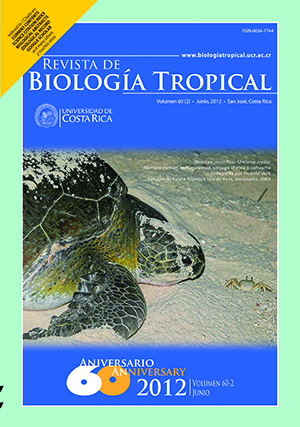Abstract
Spatial and temporal variations in phytoplankton communities in continental waters have received attention from limnologists, since they are differently influenced by many physico-chemical and biological fac- tors. This study was undertaken with the aim to identify the environmental variables that influence the temporal and spatial dynamics of the phytoplankton near a fish farm in the Jucazinho reservoir, in a semi-arid region of Northeastern Brazil. Samples were taken from three sampling sites, at two depths during the rainy (Aug 2008, Feb and Mar 2009) and dry (Oct, Nov and Dec 2008) seasons. Phytoplankton was identified, density determined, and biomass values obtained. Concomitantly, abiotic analyses were performed for the characterization of the system. The reservoir was homogeneous with regard to the spatial-temporal variation in hydrological variables: water well oxygenated at the surface and anoxic at the bottom; pH ranging from neutral to alkaline; temperatures always above 25oC; high turbidity; and high electrical conductivity at all sampling sites and both depths. For both seasons, there was limited nitrogen and high concentrations of phosphorus. Cyanophyta species were pre- dominant, generally representing 80% of the phytoplankton biomass throughout practically the entire study, at all sampling sites and both depths. Co-dominance of cyanobacteria belonging to H1, MP, S1 and Sn associations was recorded in most of the months studied, except August 2008, when there was a substitution of the S1 asso- ciation (Planktothrix agardhii) by the P association (Aulacoseira granulata). Water temperature, precipitation and pH were the parameters with the greatest influence over the temporal variation in phytoplankton, whereas the vertical distribution of the phytoplankton biomass was directly related to the availability of light in the water column. There were no spatial or temporal differences in water quality, likely due to the fact that the sampling sites were near to one another and received the same nutrients stemming from the rations given to the fish as well as their excrement. The predominance of cyanobacteria through the study was certainly due to the influence of the feeding products offered to and excreted from the fish, which eutrophicated the system. In temporal terms, the change in the algal structure is explained by the change in the physical conditions of the water between the surface and bottom, as well as the climatologic conditions, especially the change in wind direction, with the consequent fetch of the water.Comments

This work is licensed under a Creative Commons Attribution 4.0 International License.
Copyright (c) 2012 Revista de Biología Tropical
Downloads
Download data is not yet available.






